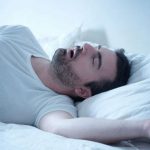 Temporary cessation of breathing while asleep. The disorder is most commonly caused by obstruction of the airway from excessive tissue associated with obesity (i.e., obstructive sleep apnea), but it can also occur when the brain does not send the signal to the muscles to take a breath, resulting in no muscular effort to take a breath (i.e., central sleep apnea).
Temporary cessation of breathing while asleep. The disorder is most commonly caused by obstruction of the airway from excessive tissue associated with obesity (i.e., obstructive sleep apnea), but it can also occur when the brain does not send the signal to the muscles to take a breath, resulting in no muscular effort to take a breath (i.e., central sleep apnea).
A periodic cessation of air flow through the mouth and nose during sleep.
A condition or syndrome characterized by poor sleep, snoring, and daytime sleepiness attributable to multiple, brief episodes of not breathing (apnea). Most patients with sleep apnea are extremely obese. Also known as the Pickwickian syndrome.
Sleep apnea is characterized by recurrent apneas (breathing cessations) during sleep, which can result in a temporary cessation or reduced flow of oxygen to the brain, as well as regular interruptions of the normal sleep pattern. At the termination of this apneic event, the patient will awaken and then resume breathing. For children with this disorder, this process is often repeated hundreds of times each night. Individuals with this disorder usually present with complaints of snoring, restlessness, lethargy, and headaches. Symptoms may be transient or more permanent, depending upon the degree of oxygen reduction and the chronicity. The incidence of sleep apnea in children can be estimated to be at between 5% and 3% of the population.
Brief periods during sleep when breathing ceases, until the brain is alerted to restart breathing. Apnea of up to 15 seconds occurs normally in all ages, but cessation of breathing for over 20 seconds is called pathologic apnea; it can result in brain damage and other problems.
Condition in which the patient has transient periods of apnea during sleep; typically, these last less than 30 seconds. Obstructive sleep apnea is caused by obstruction (e.g., large tonsils, adenoids, or thyroid gland), whereas central sleep apnea is an alteration of the central nervous system stimulus to breathe during sleep. Symptoms include excessive daytime sleepiness, snoring, and congestive heart failure. Patients may actually die in their sleep from cardiac arrhythmias caused by hypoxia. Treatment may include removal of an offending blockage, tracheostomy, or medication.
Cessation of breathing during sleep that causes awakening and is characterized by daytime sleepiness.
The temporary absence of breathing during sleep. This common disorder, which affects about 10% of all middle-aged men, and about 5% of middle-aged women, in the U.S. is classified according to the mechanism involved and by whether or not it is associated with daytime sleepiness.
A sleeping disorder characterized by interruptions of normal breathing patterns during sleep.
A disorder in which breathing stops for short periods during sleep and then resumes suddenly.
A sleep disorder characterized by temporary interruptions in breathing followed by spontaneous resumption of normal breathing is known as sleep apnea. These pauses in breathing can occur multiple times throughout the night, leading to fragmented and inadequate sleep, thus compromising its overall quality.
